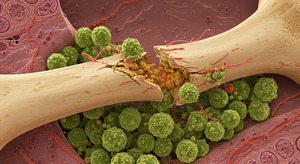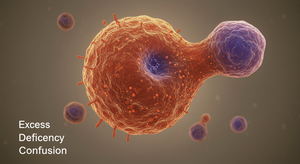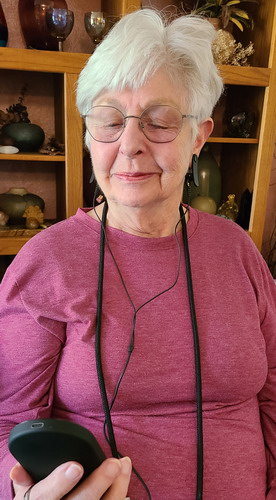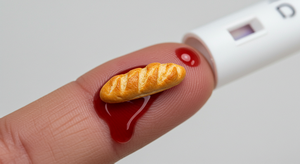I am going to start this newsletter with what might be a joke, or it might be a bit of insightful wisdom. It was told to me by Donny Epstein, the creator of Network Chiropractic, a healing protocol I practiced back in the 90s. The “joke” goes like this: What is the definition of diagnosis? When we look at the Greek roots for the word, we find gnosis, meaning knowledge or knowing, the prefix a meaning not, and di meaning two. Put that all together, and you get di.a.gnosis or two not knowing. So when a doctor examines a patient to arrive at a diagnosis, you end up with two people not knowing what is going on, the doctor and the patient! This is where you laugh somewhat uncomfortably because of how often this is true.
a joke, or it might be a bit of insightful wisdom. It was told to me by Donny Epstein, the creator of Network Chiropractic, a healing protocol I practiced back in the 90s. The “joke” goes like this: What is the definition of diagnosis? When we look at the Greek roots for the word, we find gnosis, meaning knowledge or knowing, the prefix a meaning not, and di meaning two. Put that all together, and you get di.a.gnosis or two not knowing. So when a doctor examines a patient to arrive at a diagnosis, you end up with two people not knowing what is going on, the doctor and the patient! This is where you laugh somewhat uncomfortably because of how often this is true.
Diagnosis is decidedly difficult. The magical promise o f a good diagnosis is that if you know what is going on, then you will know what to do to fix it. This is very appealing, and it works occasionally for simple problems. If you break your arm, you know you need to set the bones and then cast the arm for 6 to 8 weeks while the bone heals. On the other hand, if your hair is falling out, there are a dozen possible reasons. If you do a bunch of tests, you might decide that the problem is thyroid-related. Great, now what? There are 27 different ways thyroid hormone can be messed up. Giving thyroid hormone only helps one of those ways. Most of the thyroid answers are very complex and difficult to address. This is the real world of diagnosis most of the time.
f a good diagnosis is that if you know what is going on, then you will know what to do to fix it. This is very appealing, and it works occasionally for simple problems. If you break your arm, you know you need to set the bones and then cast the arm for 6 to 8 weeks while the bone heals. On the other hand, if your hair is falling out, there are a dozen possible reasons. If you do a bunch of tests, you might decide that the problem is thyroid-related. Great, now what? There are 27 different ways thyroid hormone can be messed up. Giving thyroid hormone only helps one of those ways. Most of the thyroid answers are very complex and difficult to address. This is the real world of diagnosis most of the time.
Developing a good and useful diagnosis is more of an art than a science. Modern medical science is built out of the statistics of large population studies. The problem is we are each individuals and none of us are average. Statistics says that the odds are good that a particular therapy or drug will help us, but too often the odds don’t play out in our favor. Too often when I look at the actual data of a study I see how absurd the study results in fact are. Here is a silly example. If you put 100 people on a magic diet for 12 weeks and half of them lose exactly 20 pounds and the other half of them gain 20 pounds, the statistical analysis will say that the diet had zero effect on the average patient. That is insane because it had zero effect on exactly no one and a huge effect on everyone. It simply had opposite effects on each half of the population studied. So if I decided that this was a perfectly safe diet that would have no effect on my weight based on the result of the study, I would be in for a big surprise.
art than a science. Modern medical science is built out of the statistics of large population studies. The problem is we are each individuals and none of us are average. Statistics says that the odds are good that a particular therapy or drug will help us, but too often the odds don’t play out in our favor. Too often when I look at the actual data of a study I see how absurd the study results in fact are. Here is a silly example. If you put 100 people on a magic diet for 12 weeks and half of them lose exactly 20 pounds and the other half of them gain 20 pounds, the statistical analysis will say that the diet had zero effect on the average patient. That is insane because it had zero effect on exactly no one and a huge effect on everyone. It simply had opposite effects on each half of the population studied. So if I decided that this was a perfectly safe diet that would have no effect on my weight based on the result of the study, I would be in for a big surprise.
So how do we develop the art in the art of diagnosis? Here I will be delving into personal opinions, because the rapidl y sliding health of America says that current diagnostic methods are failing. It says a lot that the health of the American people ranks at the very bottom of the list of all the industrialized nations of the world. Our health is lower than even some third-world countries. It is also interesting that we spend on average three to ten times as much money per person on our health as these other countries. Something is wrong here!
y sliding health of America says that current diagnostic methods are failing. It says a lot that the health of the American people ranks at the very bottom of the list of all the industrialized nations of the world. Our health is lower than even some third-world countries. It is also interesting that we spend on average three to ten times as much money per person on our health as these other countries. Something is wrong here!
My bias is built into the very name of my office – Fair Oaks Holistic Health. Holism is a philosophical perspective that is summed up in the phrase “the whole is greater than the sum of its parts.” This is the opposite direction that medical sciences have pursued. Because of the incredible complexity of the body, medical science has become super specialized, looking for information on smaller and smaller pieces of the body. How all these pieces work together to produce what we call life has been lost along the way. I take a generalist approach to the body instead of being a specialist. I am interested in how all the parts are relating and communicating with each other. My experience is that everything affects everything else. Nothing exists in isolation, and every action will affect many different parts of the body. I often find that what is believed to be illness and disease is really just failures to communicate between different parts of the body.
that is summed up in the phrase “the whole is greater than the sum of its parts.” This is the opposite direction that medical sciences have pursued. Because of the incredible complexity of the body, medical science has become super specialized, looking for information on smaller and smaller pieces of the body. How all these pieces work together to produce what we call life has been lost along the way. I take a generalist approach to the body instead of being a specialist. I am interested in how all the parts are relating and communicating with each other. My experience is that everything affects everything else. Nothing exists in isolation, and every action will affect many different parts of the body. I often find that what is believed to be illness and disease is really just failures to communicate between different parts of the body.
Chiropractic philosophy believes that the brain and nervous system control the body. Osteopaths believed that the  heart and blood circulation were what controlled the body. Traditional Chinese medicine saw the body as being controlled by life force called Chi or Qi moving through the body. Vedic medicine focused on the energy of prana (breath) in five basic forms (winds) which vitalizes and controls the body. Healing systems throughout time have understood that the diversity of the body is united and controlled by some greater force that arises from the interaction of all the parts together. This is the idea of holism. The essence of health is having all the parts working together in harmony.
heart and blood circulation were what controlled the body. Traditional Chinese medicine saw the body as being controlled by life force called Chi or Qi moving through the body. Vedic medicine focused on the energy of prana (breath) in five basic forms (winds) which vitalizes and controls the body. Healing systems throughout time have understood that the diversity of the body is united and controlled by some greater force that arises from the interaction of all the parts together. This is the idea of holism. The essence of health is having all the parts working together in harmony.
From this perspective, when some organ or part of the body is not working correctly, you must look at the whole sy stem to find the solution. Even something as simple as a broken bone requires the whole system to heal. The digestive system has to be providing the right nutrients to rebuild the bone. Hormones and signaling molecules convert immune cells into the type that lays down new bone. Blood vessels and cells have to provide oxygen and nutrients to the recovery site. Nerves have to grow into the area to tell the bone where to grow and when to stop. The list just goes on and on. Healing involves the whole body. This is where modern medicine has failed, in my opinion. The focus is on the injured or inflamed area and nothing else.
stem to find the solution. Even something as simple as a broken bone requires the whole system to heal. The digestive system has to be providing the right nutrients to rebuild the bone. Hormones and signaling molecules convert immune cells into the type that lays down new bone. Blood vessels and cells have to provide oxygen and nutrients to the recovery site. Nerves have to grow into the area to tell the bone where to grow and when to stop. The list just goes on and on. Healing involves the whole body. This is where modern medicine has failed, in my opinion. The focus is on the injured or inflamed area and nothing else.
Typical chiropractic is no better. Complexity is hard, and people shy away from it. Everyone wants the simple answe r, the single miracle pill. Chiropractors in the past liked to focus on the spinal subluxation as the cause and remedy for everything. Fortunately, the more modern schools are teaching a functional medicine approach to health that looks at the whole body. The second of the founders of chiropractic, B.J. Palmer, stated, “Subluxation is a symptom of interference of innate – not the cause.” Innate is the chiropractic name for Chi or Prana, the life force of the body. Adjustments to the spine will change symptoms, but they are not the cause of the problems.
r, the single miracle pill. Chiropractors in the past liked to focus on the spinal subluxation as the cause and remedy for everything. Fortunately, the more modern schools are teaching a functional medicine approach to health that looks at the whole body. The second of the founders of chiropractic, B.J. Palmer, stated, “Subluxation is a symptom of interference of innate – not the cause.” Innate is the chiropractic name for Chi or Prana, the life force of the body. Adjustments to the spine will change symptoms, but they are not the cause of the problems.
Curiously, this Functional Medicine approach to healt h was actually taught by the founder of Chiropractic, D.D. Palmer. Here is a quote that highlights this (the language is from the early 1900s) : “The determining causes of disease are traumatism, poison, and autosuggestion.” This concept has been modernized as disease is caused by structural, biochemical, and mental/emotional disturbances in the body. Here we see the integration of environmental forces impacting our health along with the quality of our nutrition versus intake of toxic substances, and the impact of our mental and emotional health as it impacts our body. This is a much more holistic approach, a much broader view of what must be considered when diagnosing a patient with complaints.
h was actually taught by the founder of Chiropractic, D.D. Palmer. Here is a quote that highlights this (the language is from the early 1900s) : “The determining causes of disease are traumatism, poison, and autosuggestion.” This concept has been modernized as disease is caused by structural, biochemical, and mental/emotional disturbances in the body. Here we see the integration of environmental forces impacting our health along with the quality of our nutrition versus intake of toxic substances, and the impact of our mental and emotional health as it impacts our body. This is a much more holistic approach, a much broader view of what must be considered when diagnosing a patient with complaints.
Just to flip things upside down, while I see modern medicine as narrowing its focus to smaller and smaller specialties,  at the same time they are getting mired in so many details that they are missing the fundamental simplicity of disease. Fortunately, I had a Pathology professor from India while in school as we were memorizing thousands of disease conditions in various tissues, who gave me the simple perspective to understand this mass of information. Disease is simple, he said, all it is is cellular dysfunction caused by either too much, too little, or confusion on the cellular level. All these diseases you are trying to understand come down to this simple understanding. The rest is just a bunch of names for all the different tissues in the body that can have these simple problems. Once I looked at it from this perspective, learning became much easier.
at the same time they are getting mired in so many details that they are missing the fundamental simplicity of disease. Fortunately, I had a Pathology professor from India while in school as we were memorizing thousands of disease conditions in various tissues, who gave me the simple perspective to understand this mass of information. Disease is simple, he said, all it is is cellular dysfunction caused by either too much, too little, or confusion on the cellular level. All these diseases you are trying to understand come down to this simple understanding. The rest is just a bunch of names for all the different tissues in the body that can have these simple problems. Once I looked at it from this perspective, learning became much easier.
Diagnosis – is it two people failing to understand? T oo often it is just that. The focus is on how to make the symptom go away, make the complaint feel better. It is rarely about building health. Doctors are not looking at how all the parts of the body are involved, nor are they looking at how to restore cellular health and balance on all levels. These days they at least give lip service to stress being a cause for problems, but they offer no answers that address the underlying causes of that stress. Medical doctors have literally no training in nutrition, which is fundamental to providing the cells with what they need to be healthy. They are good at addressing traumatic injuries and sometimes look for environmental poisons that might be causing disease symptoms. This is good, but these are just tiny pieces of the much larger puzzle.
oo often it is just that. The focus is on how to make the symptom go away, make the complaint feel better. It is rarely about building health. Doctors are not looking at how all the parts of the body are involved, nor are they looking at how to restore cellular health and balance on all levels. These days they at least give lip service to stress being a cause for problems, but they offer no answers that address the underlying causes of that stress. Medical doctors have literally no training in nutrition, which is fundamental to providing the cells with what they need to be healthy. They are good at addressing traumatic injuries and sometimes look for environmental poisons that might be causing disease symptoms. This is good, but these are just tiny pieces of the much larger puzzle.
Yes, I completely acknowledge that addressing health is vastly complex and way beyond the capacity of any doctor I know. That is why we need a health team to look after our health. Nobody can cover all the bases themselves. We need lots of experts to advise us and guide us on our health journey. Then we have to listen to our own intuition to feel what parts of that advice we need to engage with now and what can wait until later. Each person’s body has its own priority as to what to do when. Each of our journeys is unique to us. I tell patients to go with what they are attracted to. If you are not attracted, you won’t really engage with it anyway, and engagement is a requirement to achieve success. So trust yourself, but also gather as much information and guidance as you can.
I know. That is why we need a health team to look after our health. Nobody can cover all the bases themselves. We need lots of experts to advise us and guide us on our health journey. Then we have to listen to our own intuition to feel what parts of that advice we need to engage with now and what can wait until later. Each person’s body has its own priority as to what to do when. Each of our journeys is unique to us. I tell patients to go with what they are attracted to. If you are not attracted, you won’t really engage with it anyway, and engagement is a requirement to achieve success. So trust yourself, but also gather as much information and guidance as you can.
Take care,
David
Ellen
We recently acquired a device for electrically stimulating the Vagus nerve. This puts the body into a state of relaxati on to counter the effects of stress. Here we see Ellen with the device attached to her ear lobes. Numerous studies have demonstrated greatly improved health metrics when the Vagus nerve is stimulated regularly.
on to counter the effects of stress. Here we see Ellen with the device attached to her ear lobes. Numerous studies have demonstrated greatly improved health metrics when the Vagus nerve is stimulated regularly.
Now olive oil makes us fat!
New research is showing that the primary fatty aci d in olive oil, oleic acid, controls the replication of fat cells. Other fats might make existing fat cells get fatter, but oleic acid makes the fat cells produce more fat cells. This creates fat that is really hard to loose through dieting.
d in olive oil, oleic acid, controls the replication of fat cells. Other fats might make existing fat cells get fatter, but oleic acid makes the fat cells produce more fat cells. This creates fat that is really hard to loose through dieting.
___________________________
“Principle of compassion. Seeing life through another’s eyes not only allows for connection, but also shows us what will support others and give us value. “~David DeLapp
_____________________________________
New simple blood test for Celiac disease
Until now testing for celiac disease has been a difficu lt process that required you to get ill eating grains then have a biopsy of the gut to see if damage has taken place. This new blood test is very accurate and a whole lot easier.
lt process that required you to get ill eating grains then have a biopsy of the gut to see if damage has taken place. This new blood test is very accurate and a whole lot easier.
____________________________
“Principle of acceptance. “What is” is what is. All perceptions and actions we make are false and failing until we embrace reality as it is. “
~David DeLapp
________________________________________
Short chain fatty acids protect against heart disease
Short chain fatty acids are created by gut bacteria wh en they break down soluble fiber. These fatty acids lower blood pressure and reduce inflammation, both of which reduce heart disease. So eat your fiber!
en they break down soluble fiber. These fatty acids lower blood pressure and reduce inflammation, both of which reduce heart disease. So eat your fiber!
________________________
“Principle of active hope. Active hope recognizes the constantly changeable nature of reality and works today for a better tomorrow. Passive hope just wishes to be given a better tomorrow without work.“
~David DeLapp
|
|
|
